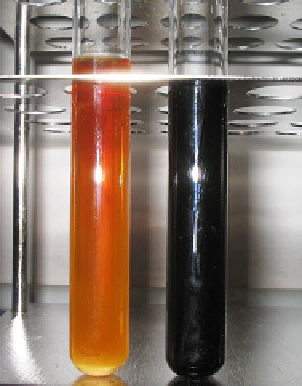Environmental Engineering Reference
In-Depth Information
Fig. 1 Decolorization of azo
dye, remazol black B by
Halomonas sp. D2. The right
tube contains decolorization
medium without inoculation
and the left tube is inoculated
with the strain and it shows
decolorization after 96 h
incubation
Exiguobacterium acetylicum, Exiguobacterium indicum and Staphylococcus
gallinarum are able to decolorate Reactive Black 5 dye in medium containing
60000 ppm NaCl (Chen et al.
2011
). Halotolerant Exiguobacterium sp. has the
ability to ef
ciently decolorize azo dye X-3B at 15 % (w/v) NaCl (Tan et al.
2009
).
Three halophilic and halotolerant strains of the genus Halomonas have been
reported with the high ability of azo dye decolorization (Fig.
1
) in a wide range of
NaCl concentration (up to 20 % w/v), temperature (25
40
°
C) and pH (5
11) after
-
-
5 days of incubation (Asad et al.
2007
).
Halomonas sp. strain GTW, which was isolated from the coastal sediments, is
able to grow well and completely decolorize K-2BP (98 %) at 30
C (Guo et al.
2008a
). Azo dye decolorization has been also reported with Shewanella aquima-
rina, which is able to grow at up to 7 % (w/v) NaCl (Meng et al.
2012
). Further,
research also showed that Shewanella putrefaciens strain AS96 could be effective
for treatment of colored industrial wastewater containing high salt concentration up
to 60 (g l
−
1
) NaCl (Khalid et al.
2008b
). Psychrobacter alimentarius strain KS23
and Staphylococcus equorum strain KS26 which were isolated from seawater
sediment, were able to decolorize three reactive dyes including Reactive Black 5,
Reactive Golden Ovi
°
x, and Reactive Blue BRS in medium with range of
100 g l
−
1
NaCl concentration (Khalid et al.
2012
). A halophilic strain was
isolated from a solar sea-saltern in Turkey and found to be resistant against Lanaset
Navy R and Lanaset Brown B dyes. According to 16S rRNA gene sequence
analysis, the strain C-22 belongs to the genus Halobacillus which was the
0
-
rst
report for its ability of this genus in azo-metal complex dyes decolorization
(Demirci et al.
2011
). A novel halotolerant bacterium Gracilibacillus sp. GTY was
isolated, showing the ability of dye decolorization by growing and resting cells, as
well as by extracted azo reductase. This strain was able to grow in the media with
15 % (w/v) of NaCl. Decolorization ef
ciency of the strain grown in very low,
or high concentrations did not suggest
that salt concentrations controlled the

Search WWH ::

Custom Search